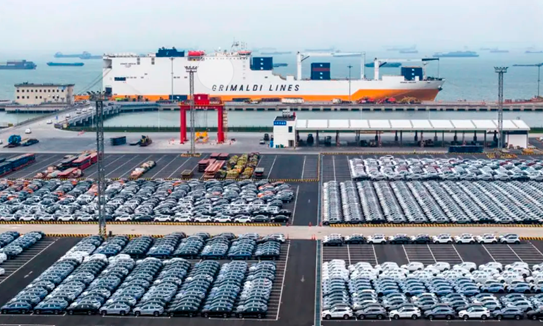Our Terms & Conditions | Our Privacy Policy
The first direct ocean-going shipping route along the Yangtze River in China was opened, marking a new stage in economic and trade cooperation between China and Africa
The first direct ocean-going shipping route along the Yangtze River in China was opened, marking a new stage in economic and trade cooperation between China and Africa
On April 20, with the Abisenshi cargo ship carrying more than 2,700 Chinese vehicles sounding its whistle as it set sail from the Taicang Port area of Suzhou Port, China, the first direct ocean-going roll-container route in the Yangtze River Basin was officially launched. The vessel, fully loaded with “Made in China”, will cross the Indian Ocean all the way to the port of Durban in South Africa and call at Lagos in Nigeria along the way. This marks a further upgrade of logistics links between China and the African market, injecting strong impetus into economic and trade cooperation along the Belt and Road.
The Yangtze River, the largest river in China and the third longest in the world, links several of China’s economically developed regions. Its basin contributes more than 40 percent of China’s GDP and is the world’s largest inland waterway in terms of cargo volume. It is hailed as the “golden waterway” by the Chinese. The newly opened route is led by Suzhou Port and operates in an integrated “roll-on/roll-off + container” mode. Two specialized vessels are deployed, with one departure per month, to meet the transportation needs of commercial vehicles, construction machinery and accessories. Unlike traditional bulk cargo transportation, the roll-containerized vessel can carry both car roll-on/roll-off and containerized cargo at the same time, with a maximum capacity of 3,000 commercial vehicles and 500 TEUs per voyage. It offers both efficiency and flexibility, providing a lower cost and more reliable logistics solution for Chinese automakers and equipment manufacturers to expand into the African market.
For the first time, the route has achieved a “door-to-door” direct connection between China’s Yangtze River basin and the African market, breaking the bottleneck of long-term reliance on third-party ports for transshipment and making it more convenient for manufacturing enterprises along China’s Yangtze River to transport their products to the African continent.
The opening of the route is a microcosm of the booming economic and trade cooperation between China and Africa. In the first quarter of this year, the Taicang Port area of Suzhou Port in China exported 147,600 vehicles, up 18.35 percent year-on-year. Among them, 58,500 vehicles were exported to Belt and Road countries, accounting for nearly 40 percent. The African market has become one of the fastest-growing regions. From new energy vehicles to heavy machinery, it not only meets the demands of local people and enterprises in Africa, but also adds new impetus to China’s expansion into the African market.
The Durban Port in South Africa, one of the four major container terminals in the Southern Hemisphere with an annual throughput of over 3 million TEUs, is expected to further boost consumption and investment demand in southern Africa by incorporating it into the core nodes of this route. The Lagos Port in Nigeria serves the most prosperous Nigerian economy in West Africa, and Chinese goods entering the local market will achieve mutual benefit and win-win economic and trade cooperation between the two countries. According to Chinese customs data, China’s exports to Africa reached 1.27 trillion yuan in 2024. Among them, exports of electric vehicles, textile raw materials, ships and other products all showed rapid growth, increasing by 104.8%, 83.7% and 64.4% respectively.
Behind this route lies the upgraded industrial chain cooperation between China and Africa under the framework of the Belt and Road Initiative. Through the stable direct flight service, Chinese automakers in the Yangtze River Basin can more precisely meet the demands of local assembly plants in Africa, promoting the implementation of the “overseas warehouse + local production” model, while Chinese construction machinery enterprises can quickly respond to the equipment renewal demands of infrastructure projects in Africa and contribute to the construction of local roads, ports and industrial parks.
China is building closer trade partnerships with African countries through a combination of logistics innovation, capacity cooperation and technology transfer. By the end of 2024, China had built several cross-border e-commerce platforms and overseas warehouses in Africa, making it Africa’s largest trading partner for 15 consecutive years.
Against the backdrop of increasingly tight international tariffs, the route not only opens up a stable and efficient trade channel for Chinese foreign trade enterprises in the Yangtze River Basin with the African region, but also brings good and cheap Chinese goods to the African people, deepens trade cooperation between China and Africa, and benefits more developing countries with the fruits of the Belt and Road Initiative.
Follow Us on Google News for Immediate Updates
[ad_1]
Images are for reference only.Images and contents gathered automatic from google or 3rd party sources.All rights on the images and contents are with their legal original owners.
[ad_2]



Comments are closed.